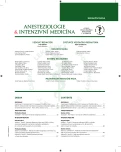Strong ion difference (SID) in critically ill patients with normal arterial pH, pCO2, BE and HCO3- and its impact on mortality
Authors:
Večeřa Lubomír; Turek Radovan
Authors‘ workplace:
Anesteziologicko-resuscitační oddělení, Krajská nemocnice Tomáše Bati, a. s., Zlín
Published in:
Anest. intenziv. Med., 25, 2014, č. 2, s. 88-97
Category:
Intensive Care Medicine - Original Paper
Overview
Objective:
To identify acid-base disturbances according to the Stewart-Fencl approach in critically ill patients with normal arterial pH, pCO2, HCO3- and BE. To compare the SIDapp, SIDef, SIG and AGkor values in the patients who were vs. were not alive at three months from ITU admission.
Design:
Single-centre, retrospective, observational study.
Setting:
Anaesthesiology and Resuscitation Department of a Regional Hospital.
Materials and methods:
The criteria (normal arterial pH, pCO2, BE, HCO3-) were met by 112 critically ill patients. In these patients, the parameters needed to calculate the SID and SIG were sampled. Thirty nine of the patients died within three months of admission, 50 patients survived longer than 3 months and 23 patients were eliminated from the subsequent part of the study. SIDapp, SIDef, SIG and AGkor values were calculated in all these patients.
Results:
A total of 110 patients had abnormal SIDef values (98.21%), 107 patients had abnormal SIDapp values (95.54%), 52 patients had SIG values above 5 mmol/l (46.43%) and 4 of them over 10 mmol/l (3.57%). There was a statistically significant difference between the non-survivors and survivors in the SIDapp (p < 0.01), SIG (p < 0.005) and AGkor (p < 0.005) values. There was no statistically significant difference between the SIDef values.
Conclusion:
This study confirmed that the majority of critically ill patients admitted to the ITU with normal parameters of arterial pH, pCO2, HCO3- and BE have acid-base disturbances according to the Stewart-Fencl approach. We found a significant difference in SIDapp, SIG and AGkor values between the survivors and the non-survivors.
Keywords:
acid-base disturbances – Stewart-Fencl approach – strong ion difference (SID) – critically ill patients
Sources
1. Corey, H. E. Stewart and beyond: New models of acid-base ba-lance. Kidney International, 2003, 64, p. 777–787.
2. Stewart, P. A. Modern quantitative acid-base chemistry. Canad. J. Physiol. Pharmacol., 1983, 61, p. 1444–1461.
3. Fencl, V. et al. Diagnosis of acid-base disturbances in critically ill patients. Am. J. Crit. Care, 2000, 162, p. 2246–2251.
4. Badr, A., Nightingale, P. An alternative approach to acid-base abnormalities in critically ill patients. Contin. Educ. Anaesth. Crit. Care. Pain., 2007, 7, 4, p. 107-111.
5. Story, D. A. et al. Hyperchloremic acidosis in the critically ill: One of the strong-ion acidoses? Anesth. Analg., 2006, 103, p. 144-148.
6. Schück, O. et al. Vztah mezi pH a diferencí silných iontů (SID) ve vnitřním prostředí. Klin. Biochem. Metab., 2005, 1, s. 32–35.
7. Nicholson, J. P. et al. The role of albumin in critical illness. Br. J. Anaesth., 2000, 85, p. 599-610.
8. Kazda, A. Vnitřní prostředí II – acidobazická rovnováha, kyslíkové parametry, laktát. In Kazda, A. et al. Kritické stavy. Metabolická a laboratorní problematika. Praha: Galén, 2012, s. 46.
9. Boniatti, M. M. et al. Acid-base disorders evaluation in critically ill patients: we can improve our diagnostic ability. Intensive Care Med., 2009, 35, 8, p. 1377-1382.
10. Kaplan, L. J. et al. Comparison of acid-base models for prediction of hospital mortality after trauma. Shock, 2008, 29, 6, p. 662-666.
11. Zehtabchi, S. et al. Utility of Stewart’s strong ion difference as a predictor of major injury after trauma in the ED. Am. J. Emerg. Med., 2007, 25, 8, p. 938-941.
12. Cusack, R. J. et al. The strong ion gap does not have prognostic value in critically ill patients in a mixed medical/surgical adult ICU. Intensive Care Med., 2002, 28, 7, s. 864-869.
13. Dubin, A. et al. Comparison of three different methods of evaluation of metabolic acid-base disorders. Crit. Care. Med., 2007, 35, 5, s. 1264-1270.
Labels
Anaesthesiology, Resuscitation and Inten Intensive Care MedicineArticle was published in
Anaesthesiology and Intensive Care Medicine

2014 Issue 2
Most read in this issue
- Static and dynamic tests for management of volumotherapy
- Current practice in obstetric anaesthesia IV. – Anaesthesia complications in caesarean section
- Methods of extracorporeal oxygenation and C2 removal primarily for lung support
- Fast-track is not only an inoffensive anaesthesia
